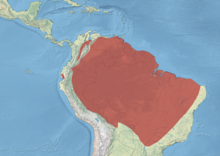Horned screamer
| Horned screamer | |
|---|---|
 |
|
| Three in Manu National Park, Peru | |
| Scientific classification | |
| Kingdom: | Animalia |
| Phylum: | Chordata |
| Class: | Aves |
| Order: | Anseriformes |
| Family: | Anhimidae |
| Genus: |
Anhima Brisson, 1760 |
| Species: | A. cornuta |
| Binomial name | |
|
Anhima cornuta (Linnaeus, 1766) |
|
 |
|
| Distribution map | |
The horned screamer (Anhima cornuta) is a member of a small family of birds, the Anhimidae, which occurs in wetlands of tropical South America. There are three screamer species, the other two being the southern screamer and the northern screamer in the genus Chauna. They are related to the ducks, geese and swans, which are in the family Anatidae, but have bills looking more like those of game birds.
The horned screamer is a massive 84–95 cm (33–37.5 in) long, 3.5 kg (7.7 lb) bird, with a small chicken-like bill. The upperparts, head, and breast are black, with white speckles on the crown, throat and wing coverts. There is a long spiny structure projecting forward from the crown. This structure is unique among birds and is not derived from a feather but is a cornified structure that is loosely attached to the skull and grows continuously while often breaking at its tip it has very long and lanky legs and three large toes in each. This gives this species its name. The belly and under wing coverts are white. It has two sharp spurs on its wings and feet which are only partially webbed.
The horned screamer's call, as its name suggests, is a very loud echoing sound.It is called"El Clon-Clon" in Ecuador because of this peculiar feature.
The horned screamer is found in lowlands from Colombia, Venezuela, Brazil, Bolivia, Peru, Ecuador, Suriname, French Guiana, and Guyana. It is now extinct in Trinidad and Tobago. Despite having declined locally, it remains widespread and is fairly common overall. Its range in Brazil appears to have expanded in recent years.
...
Wikipedia

